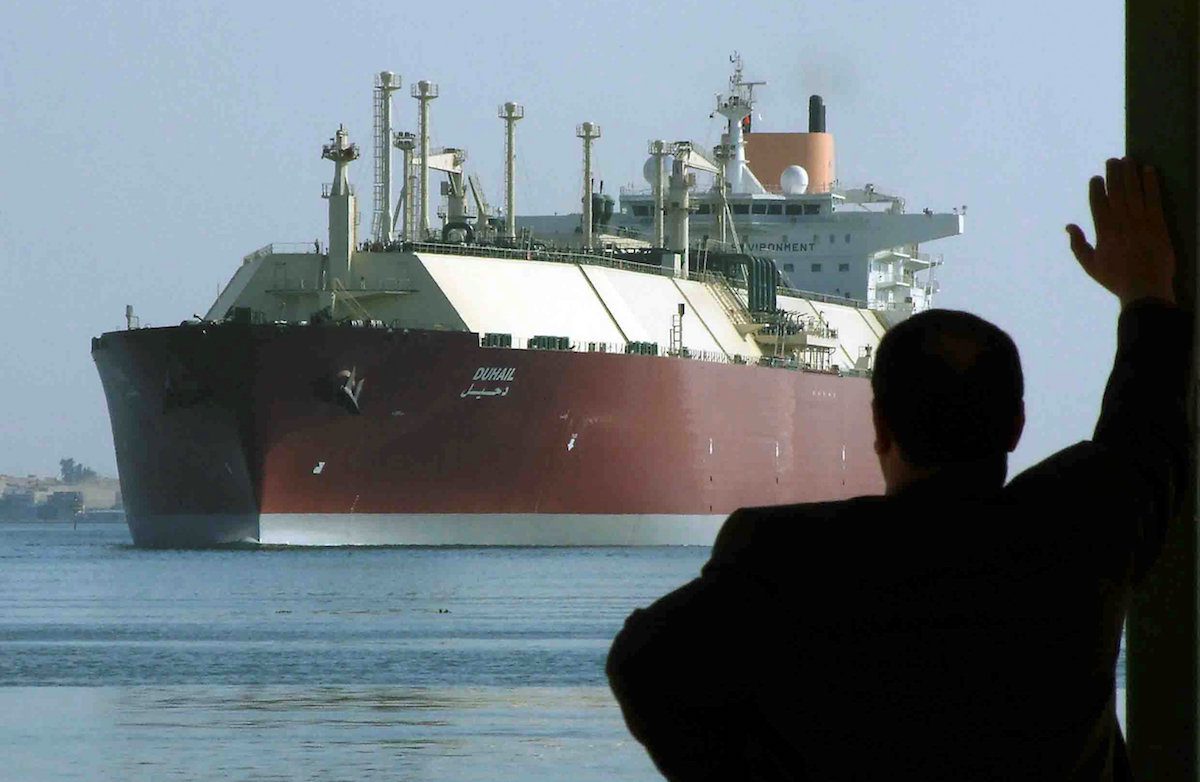FILE PHOTO: A man looks as the world’s biggest Liquefied Natural Gas (LNG) tanker DUHAIL as she crosses through the Suez Canal April 1, 2008. REUTERS/Stringer/File Photo
By Liam Denning (Bloomberg Gadfly) — The world’s oil majors, beset by intimations of demand for their favorite product leveling off, seek comfort from an invisible friend.
Compared to oil and coal, natural gas looks less fossilized. Long-term outlooks routinely show demand rising while it flattens for oil and falls for coal. This makes sense: Gas is versatile, useful both as a source of energy and a building block for chemicals; plus, when burned, it emits less carbon.
In an increasingly electrified world where regulations around pollution are tightening, gas should be a relative winner. Oil majors have adjusted accordingly:
However, their enthusiasm has, as so often, resulted in excess supply, especially of liquefied natural gas, expected to last through the early 2020s.
And the long-heralded “golden age” of natural gas isn’t a foregone conclusion.
In its latest long-term outlook, the Energy Information Administration cut projections for global gas consumption; the annual growth rate from 2020 to 2040 is now 1.7 percent, compared with 2.1 percent in last year’s outlook.
Those 40-odd basis points may not sound like much. But over time, they add up to a market in 2040 that would be smaller than previously forecast, to the tune of 72 billion cubic feet a day. That’s like the entire U.S. market, the world’s biggest, vanishing.
As with so much else in 21st-century energy, Asia is the decisive battleground for gas. The region accounts for half the expected growth in demand between 2020 and 2040; just China and India together account for 29 percent.
The Decisive Battleground For Natural Gas: Asia
Yet, as you can see, judging the growth rates for these relatively new markets is tricky. And this matters when Asia’s gas supply comes overwhelmingly from multi-billion-dollar, multi-decade LNG and pipeline projects.
Alex Dewar of Boston Consulting Group’s Center for Energy Impact thinks growth of even 1.6 percent a year over the long term could require some heroic assumptions.
Take the critical Chinese market. As elsewhere, this country’s power sector is a critical source of demand; and this is projected to rise from about 3 billion cubic feet a day in 2015 to almost 15 billion cubic feet a day in 2040. Already, that implies average annual growth at about double the pace recorded between 2010 and 2015, in terms of absolute volume of gas.
Furthermore, under Dewar’s assumptions, it implies China building 8.7 gigawatts of gas-fired generation capacity every year through 2040, versus the 5 gigawatts built annually between 2010 and 2015. Even using more-generous assumptions of plants burning only 7,500 BTU per kilowatt-hour and running 40 percent of the time, China would need to be building 6.7 gigawatts each year to underpin that growth in natural gas demand. India’s rate of building would have to accelerate at an even faster pace.
The critical factor is price. Natural gas has always been priced relative to other fuels. It is very difficult to store and transport, and the huge upfront investments in pipelines and other infrastructure this necessitates have required long-term supply contracts. These have usually been priced relative to oil.
Even as the growing trade in competing LNG cargoes has helped to loosen contract terms, this fundamental characteristic of gas won’t disappear completely when it comes to generating electricity, where the fuel must compete with coal and, increasingly, renewable power.
Analysts at the World Energy Council considered this question in a recent report. They calculated the prices at which gas and coal would compete with renewable projects priced at between two and four cents per kilowatt-hour, in line with recent long-term power purchase contracts. The chart below recreates the results, showing the equivalent gas price at various renewable-power costs — and with a theoretical carbon price of $20 per tonne factored in, too:
Even at the top end there, the implied competitive price for gas is only about $7 per million BTU, undercutting current spot prices of about $7 to $9 for Australian and Qatari LNG cargoes heading to Northeast Asia, and also U.S. cargoes, assuming a Nymex price of $3 plus tolls and shipping charges of $4 to $5.
Importantly, plants running on gas have the advantage of being able to respond to changes in power demand, while renewable projects cannot, so there are factors other than simple energy-equivalency to consider when it comes to these comparisons. Yet bulls shouldn’t rely on this argument alone — especially as, apart from renewable-technology costs, natural gas is also racing against falling battery-storage costs.
More importantly, gas could find itself squeezed between a combination of renewable power and coal. That isn’t exactly the future imagined by green enthusiasts, but coal proved to be remarkably resilient in several European countries between 2010 and 2014 — in part because carbon prices were on the floor and oil-linked gas prices in the region jumped.
Looking at China and India, while they have very good reasons to reduce coal consumption — urban pollution, chiefly — the pace at which this happens will be influenced by, among other things, the politics of employment (see this week’s announcement from the EPA for an example of how that works in another big energy-consuming country).
Realizing the “golden age” for gas will, therefore, depend to a large degree on policy and price. Carbon pricing or limits, while unhelpful in competing with renewable sources, would at least help natural gas muscle further into coal’s market share (as the oil majors are well aware already).
Ultimately, though, the main weapon in this battle is price, especially in those all-important Asian markets.
On that front, the current glut may actually be helpful. As BCG’s Dewar points out, low prices hurt sellers in the short term, but they also encourage potential buyers to build infrastructure like power plants and import terminals — facts on the ground that can underpin demand for decades to come. The shape of the mid-century global gas market may well get decided in the next five years.
Liam Denning is a Bloomberg Gadfly columnist covering energy, mining and commodities. He previously was the editor of the Wall Street Journal’s “Heard on the Street” column. Before that, he wrote for the Financial Times’ Lex column. He has also worked as an investment banker and consultant.
This column does not necessarily reflect the opinion of Bloomberg LP and its owners.
© 2017 Bloomberg L.P

 Join The Club
Join The Club











